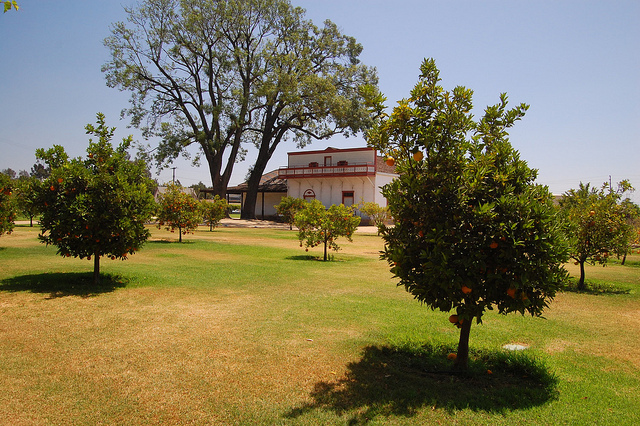
The one-time home of Pío de Jesus Pico IV, last governor of California during Mexican rule, is wedged between the 605 Freeway and train tracks, and crisscrossed overhead by jets closing in on Long Beach and Los Angeles International airports. Since 1927, it’s been the site of Pío Pico State Historic Park. It had been one of 70 parks scheduled to close on July 1 because of cuts in state funding, but a major donation by the city of Whittier, along with the support of private donations, raised $40,000 to keep it open until the end of the year. It will take another $40,000 to keep it open until July 2013.

I’ve been by the park hundreds of times. Several years ago, I had the windows on my Honda tinted at the shop across the street (I felt mildly vindicated to see that the shop now displays an “Under New Management” sign–but that’s another story). In high school we’d pass by the park’s ivy-covered walls on our way to a liquor store that sold beer without asking our age. I knew some of Pío Pico’s history, probably thanks to Huell Howser, patron saint of the modest California landmark, but the walls of the park had always presented themselves with the uninteresting and infrastructural familiarity of power lines, and I always drove past.
I visited on a recent Sunday and first discovered that the ivy isn’t ivy at all. The park walls are topped with grapevines, and they give the place an air of serenity befitting a monastery or the sort of prison where crooked stockbrokers get sent. Even with the nonstop commotion of car traffic from Whittier Boulevard to the north and the freeway’s faint din, I had the sense of being shut away from the larger world.
The park’s north end is enclosed by a stand of tall, broad-leafed oak trees. I took a seat at one of the picnic tables to regard El Ranchito, the vaguely Western, single-story structure that Don Pío called home. It’s made of adobe bricks and is coated in cracking white plaster. Surrounding it is a five-acre expanse of lawn and gardens dotted with young orange trees. There are more grapevines being cultivated on the west end of the property. It was easy to envision families from all over the San Gabriel Valley enjoying a weekend afternoon here, as El Ranchito is a picturesque sight. But when I started toward the house, the oranges revealed themselves to be undernourished, and I noticed that a third of the trees were dead, their branches withered to tinder. The grass underfoot was green, but it crunched as I walked.
The exhibits inside El Ranchito pieced together a trite, disappointing impression of life in Don Pío’s time: bedside ephemera, shards of an old bowl, a sturdy plow once used to plant corn. There was an instructional diagram on adobe and small wooden blocks meant to be a hands-on demonstration of how El Ranchito was built. In the parlor, I passed a piano to enter another room with a dinner scene. One door opened to a screening room with crooked rows of folding chairs and a wall-sized screen displaying menu options from an unmanned video station. A messy stack of instructional DVDs lay atop it. A remote control had also been left out, but there weren’t any instructions on how to use it.
Don Pío was a complicated figure, a proud Mexican whose walking stick bore the Spanish king’s seal, a Californio whose indigenous and African and Italian bloodlines formed a complex family tree. Even after the Mexican-American War, he remained one of the richest men in California. Known for his grandiose hospitality, he built the most lavish hotel in Los Angeles. Eventually, though, he lost hundreds of thousands of acres of land by signing a contract that he was unable to read. In the end, irreversibly leveraged by a lifetime of extravagance and a weakness for gambling, Don Pío was evicted from El Ranchito at the age of 91 with whatever could be piled onto a horse-drawn buggy.
There was one smaller display attempting to present several facets of Don Pío’s life. Composed of multi-sided panels, it seemed to be the most honest object in El Ranchito. The leftmost panel disdained him for seeming like a mule, while the rightmost one suggested that he should be a role model of perseverance and bravery. But the wheel to reveal the other panels was broken. And because the displays and literature in El Ranchito aren’t forthcoming or direct about the details of Don Pío’s life and the prickly implications behind them, I exited feeling insulted. I left feeling lied to.
The most peaceful place in the park is at the rear, near the train tracks, where a shaded picnic table overlooks a glen. Sitting there, it was easy to imagine Don Pío entertaining early Angeleno society in the Victorian-era clothing he favored. While the city of Whittier and the park’s supporters have rallied to save Pío Pico State Park, it would be a shame to let the rest of the orange trees die this coming December, to let the grapevines dry out and wither. But in six months I will still be part of a society that routinely votes down initiatives that would keep parks like this open without the need for last-minute heroics, a society that instead encourages me to rent rims for my car and to try the new Taco Bell taco because the shell is made of Doritos. I will still be part of a society that doesn’t read the fine print and instead prefers to think that the multitude of vacant storefronts and foreclosures around us is someone else’s fault.
Don Pío’s story ended tragically because of deep, human flaws: Indulgence. Pride. Greed. (And that’s before we get to his desire to control the region’s water rights.) But we don’t really like that sort of story when it hits so close to home. Perhaps that’s why people drive by Pío Pico’s park without stopping in to visit–and why I was there alone on a sunny Sunday afternoon.
Michael Jaime-Becerra teaches Creative Writing at UC Riverside.
*Photo courtesy of California Pete.




Send A Letter To the Editors